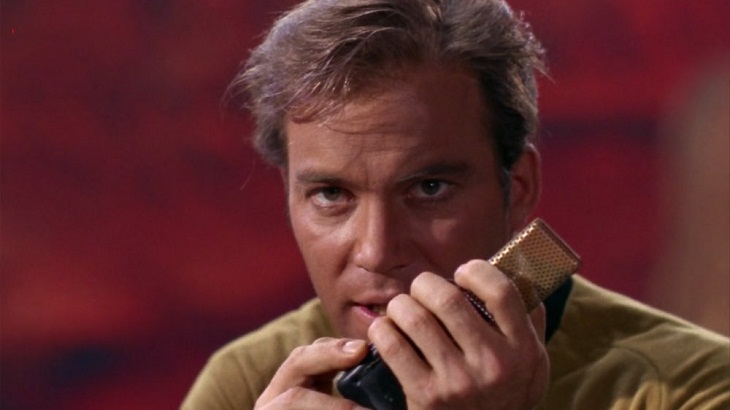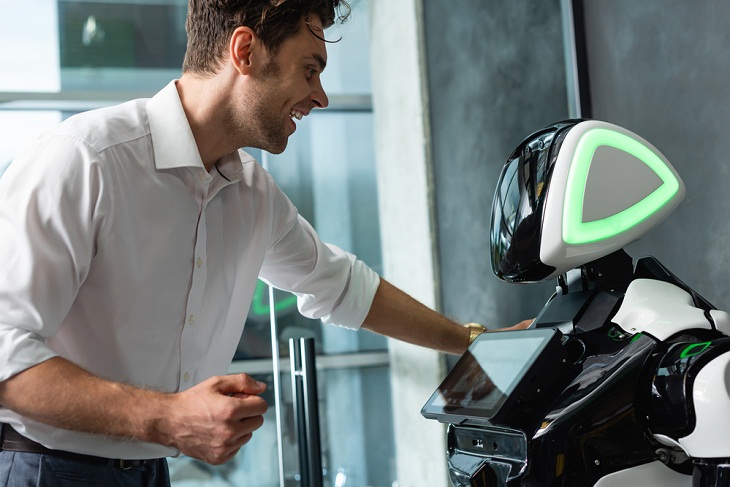Star Trek introduced the concept of a portable communication tool known as a "communicator." This innovative device made it possible for characters in the iconic TV show to engage in long-distance communication, as exemplified by Captain Kirk's ability to contact the orbiting Enterprise while situated on a distant planet's surface. This depiction served as inspiration for Martin Cooper, then the head of Motorola’s communications systems division, to invent the mobile phone. Initially, the device had a bulky design, offering a mere 30 minutes of talk time and requiring a 10-hour recharge. However, it has undergone significant refinement over the years, evolving into the sleek and compact devices that have now become indispensable in our daily lives.
2. Atomic Bomb
H.G. Wells' 1914 novel, The World Set Free, refers to a uranium-based hand grenade with an infinite explosive capacity. Remarkably, three decades later, the United States deployed two nuclear bombs in Japan, devastating Hiroshima and Nagasaki.
Wells' portrayal of an atomic bomb even included the notion of it being dropped from an aircraft. The author was acutely aware of the devastation a nuclear weapon was capable of wreaking. In The World Set Free, atomic bombs play a significant role in a catastrophic war that prompts the survivors to establish a global government, aiming to safeguard unity and prevent future ruin.
While Wells' understanding of nuclear explosions may not align accurately with reality, envisioning them as perpetually exploding bombs, he does correctly predict the long-lasting devastation inflicted on cities by nuclear weapons. The extent to which early nuclear scientists drew inspiration from Wells remains a subject of debate.
3. Credit Cards

Back in 1888, author Edward Bellamy released a utopian novel titled Looking Backward, wherein he introduced the term "credit card" to describe a plastic slip utilized for making purchases. The functionality of this concept resembled that of a contemporary debit card, as citizens used it to spend their government-issued dividends. In the book, people were allocated an equal amount of credit, empowering them to utilize it for any purpose they desired:
"a credit card issued him with which he procures at the public storehouses, found in every community, whatever he desires whenever he desires it. This arrangement, you will see, totally obviates the necessity for business transactions of any sort between individuals and consumers."
Modern credit cards serve as borrowing instruments, allowing individuals access to a predetermined sum of money. It is undeniable, however, that this depiction accurately captures the essence of card transactions as they exist today.
4. Smartwatches and Tablets

Seeing people donning smartwatches or immersed in tablets has become a common sight in 2023. The very first tablet was produced in 2001 while the first smartwatch was introduced in 1998.
Remarkably, the American animated sitcom The Jetsons accurately foretold the advent of both these technologies several decades before their widespread adoption. George Jetson, the central character, frequently perused the news on a digital device that bore a striking resemblance to the iPad. Moreover, wearable technology played a crucial role in keeping George and his family interconnected, with even their son Elroy embracing the use of a smartwatch.
5. Submarines
Submarines have been around since at least the 1600s, albeit in primitive forms. Early submarines relied on manual propulsion through human hands or heat-driven piston engines. Jules Verne, the author of the renowned adventure novel Twenty Thousand Leagues Under the Seas, played a crucial role in shaping our modern perception of submarines. The novel's protagonist, Captain Nemo, captained the Nautilus, a remarkable vessel resembling today's submarines and powered by electricity.
The French submarine "Gymnote," constructed in 1888, was a closer representation of Verne's visionary Nautilus than its predecessors. Notably, the Gymnote utilized electric power, aligning with the concept introduced in Verne's novel.
6. Robot Helpers
In 1920, Karel Čapek, a Czech author, wrote the play R.U.R. (Rossum's Universal Robots), introducing the term "robots," though it aligned more closely with the concept of androids. These synthetic beings were portrayed as emotionless, highly efficient workers lacking self-awareness.
Philip K. Dick published a short story titled Nanny in 1955, depicting a robot that cared for a family to such a remarkable extent that they resisted acquiring a replacement. Similar robotic assistants are a recurring theme in science fiction literature, films, and television shows.
We are yet to see domestic robots that come close to the capabilities portrayed by their fictional counterparts. The prevailing models are typically specialized machines with limited or no artificial intelligence. Nevertheless, robotics is progressing rapidly, approaching science fiction levels of sophistication.
7. Video Calling
Nowadays, video calling is primarily conducted through platforms such as Skype, WhatsApp, Google Meet, and FaceTime,. Interestingly, though, this method has been depicted in movies for many decades. In one of the earliest references, the 1927 film Metropolis featured an analog videophone mounted on a wall. The movie showed a character using four dials to locate the correct frequency before initiating a call.
Over time, the portrayal of video calls in movies became increasingly sophisticated. In the 1968 film 2001: A Space Odyssey, for instance, video calls were made by entering a number on a type-pad attached to a large phone unit.
Fast forward to 1989, and the film Back to the Future Part II introduced a video calling system that displayed the caller's personal information, such as favorite drinks and hobbies.
8. Automatic Doors
When the Sleeper Wakes, a 1910 novel by H.G. Wells, features a remarkable scene where two individuals effortlessly traverse what initially appears to be an impenetrable wall. As they approached, the wall swiftly "rolled up with a snap," granting them access before seamlessly closing once more.
Wells' depiction of automated doors in his book stands as one of the earliest and most accurate descriptions resembling the technology we are familiar with today. Several years later, in 1954, Dee Horton and Lew Hewitt invented automatic doors that opened on both sides of an entrance.
9. Earbuds
Ray Bradbury's 1953 novel Fahrenheit 451 featured futuristic devices called "seashells" and "thimble radios," which bear a striking resemblance to today's wireless earbuds and headsets equipped with Bluetooth technology. Today, wireless earbuds have become incredibly popular, with millions of people using them to enjoy music and manage phone conversations.
In his book, Bradbury vividly described the seashells as devices capable of producing "an electronic ocean of sound, of music and talk and music and talk, coming in on the shore of [your] unsleeping mind."
10. Self-Driving Cars
In 1964, Isaac Asimov wrote a piece for the New York Times in which he speculated on the state of the world 50 years later, imagining scenarios that have materialized to remarkably accurate effect. Notably, he foresaw the creation of a car featuring an advanced "robot-brain."
"Much effort will be put into the designing of vehicles with 'robot-brains' – vehicles that can be set for particular destinations and that will then proceed there without interference by the slow reflexes of a human driver," Asimov wrote.
Science fiction literature and media have often depicted cars of this kind. Among the notable examples is K.I.T.T. from the 1982 television series Knight Rider. Similarly, James Bond's adventures often involved cars possessing some form of autonomous feature. In the 1969 film The Love Bug, viewers were introduced to Herbie, the beloved Volkswagen Beetle with a mind of its own and capable of autonomous driving.
In 2009, Google initiated the Self-Driving Car Project, now known as Waymo, a company that provides autonomous taxi services to the general public. Since then, numerous other companies have joined the race to develop their own self-driving vehicles, with the goal of deploying them on public roads by 2030.










